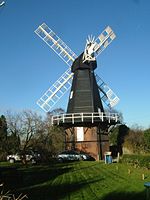The Coldrum Long Barrow, also known as the Coldrum Stones and the Adscombe Stones, is a chambered long barrow located near the village of Trottiscliffe in the south-eastern English county of Kent. Probably constructed in the fourth millennium BCE, during Britain's Early Neolithic period, today it survives only in a state of ruin.
Archaeologists have established that the monument was built by pastoralist communities shortly after the introduction of agriculture to Britain from continental Europe. Part of an architectural tradition of long barrow building that was widespread across Neolithic Europe, the Coldrum Stones belong to a localised regional variant of barrows produced in the vicinity of the River Medway, now known as the Medway Megaliths. Of these, it is in the best surviving condition. It lies near to both Addington Long Barrow and Chestnuts Long Barrow on the western side of the river. Two further surviving long barrows, Kit's Coty House and Little Kit's Coty House, as well as possible survivals such as the Coffin Stone and White Horse Stone, are located on the Medway's eastern side.
Built out of earth and around fifty local sarsen-stone megaliths, the long barrow consisted of a sub-rectangular earthen tumulus enclosed by kerb-stones. Within the eastern end of the tumulus was a stone chamber, into which human remains were deposited on at least two separate occasions during the Early Neolithic. Osteoarchaeological analysis of these remains has shown them to be those of at least seventeen individuals, a mixture of men, women, and children. At least one of the bodies had been dismembered before burial, potentially reflecting a funerary tradition of excarnation and secondary burial. As with other barrows, Coldrum has been interpreted as a tomb to house the remains of the dead, perhaps as part of a belief system involving ancestor veneration, although archaeologists have suggested that it may also have had further religious, ritual, and cultural connotations and uses.
After the Early Neolithic, the long barrow fell into a state of ruined dilapidation, perhaps experiencing deliberate destruction in the Late Medieval period, either by Christian iconoclasts or treasure hunters. In local folklore, the site became associated with the burial of a prince and the countless stones motif. The ruin attracted the interest of antiquarians in the 19th century, while archaeological excavation took place in the early 20th. In 1926, ownership was transferred to heritage charity the National Trust. Open without charge to visitors all year around, the stones are the site of a rag tree, a May Day morris dance, and various modern Pagan rituals.










